
Journal of Science and Transport Technology Vol. 1 No. 1, 45-58
Journal of Science and Transport Technology
Journal homepage: https://jstt.vn/index.php/en
JSTT 2021, 1 (1), 45-58
Published online 18/12/2021
Article info
Type of article:
Original research paper
DOI:
https://doi.org/10.58845/jstt.utt.2
021.en.1.1.45-58
*Corresponding author:
E-mail address:
dungvq@utt.edu.vn
Received: 13/11/2021
Revised: 06/12/2021
Accepted: 08/12/2021
Estimation of California Bearing Ratio of Soils
Using Random Forest based Machine
Learning
Dung Quang Vu1,*, Duc Dam Nguyen1, Quynh-Anh Thi Bui1, Duong Kien
Trong1, Indra Prakash2, Binh Thai Pham1
1University of Transport Technology, 54 Trieu Khuc, Thanh Xuan, Hanoi,
Vietnam
2DDG (R) Geological Survey of India, Gandhinagar 382010, India
Abstract: California Bearing Ratio (CBR) is an essential parameter utilized to
evaluate the strength of the soil subgrades and base course materials of
different types of pavements. In this study, the Machine Learning (ML)
approach has been adopted using Random Forest (RF) model to estimate the
CBR of the soil based on 10 input parameters such as Plasticity Index (PI),
Liquid Limit (LL), Silt Clay content (SC), Fine Sand content (FS), Coarse sand
content (CS), Optimum Water Content (OWC), Organic content (O), Plastic
Limit (PL), Gravel content (G), and Maximum Dry Density (MDD), which can
be easily determined in the laboratory. An experimental database was collected
from 214 soil samples, which were classified according to AASHTO M
145(clayey, gravel, sand, silty and clayey soils). The data was divided into 70%
training and 30% test data in the model study. Model performance was
evaluated using standard statistical measures such as coefficient of
determination, correlations, and errors (relative error, MAE, and RMSE). Based
on the analysis results shows the RF model is capable of correct prediction of
the CBR of the Soil.
Keywords: California Bearing Ratio; Random Forest; Machine Learning.
1. Introduction
California Bearing Ratio (CBR) is a
parameter of great importance in geotechnical
engineering to evaluate the strength of subgrade
material of pavements structures of roadways,
railways, and airfields [1]. CBR can be determined
in the field as well as in the laboratory. In the field
CBR test method, a loading jack is used to force a
piston into the soil mass and subgrade material at
the test site, and piston load is compared to the
depth of penetration to measure the relative
strength of in-situ soils and base course material
for pavement design. Field CBR equipment is
costly and difficult to carry at different locations/
sites. Therefore, laboratory methods are generally
employed for the determination of CBR of soil and
subgrade material. In the laboratory, CBR is
determined by inserting a plunger of standard
diameter at a rate of 1.3 mm/min into a compacted
soil specimen prepared at Optimum Water Content
(OWC) [2]. The CBR values of any soil samples
can be estimated either in soaked conditions or in
un-soaked conditions. Normally, the CBR values of
soaked soil samples are always lower than the
values of un-soaked samples. Therefore, the CBR
values of soaked samples are generally accepted
as a quality estimation of subgrade materials.

JSTT 2021, 1 (1), 45-58
Nguyen & Ly
46
However, the soil samples prepared at OWC need
to be kept in water saturation condition for 4 days,
and the entire exercise of determining the soil CBR
is a time- consuming process [2,13] and hence, the
construction time is affected significantly by this
process. Generally, CBR is to be determined for a
number of samples, which is costly and time-
consuming. Moreover, there is a possibility of
Plastic Limit (PL), Optimum Water Content (OWC),
disturbance of (LL), Plasticity Index (PI), and
Maximum Dry Density (MDD).
Nowadays, many researchers have applied
computer soft techniques as an effective method to
predict the desired output data, combining the real-
life problems of geotechnical engineering [3,5-8,
10,12,14-24] such as Layer Perceptron Neural
Network (MLPN), Support Vector Machine (SVM),
Gene Expression Programming (GEP), Artificial
Neural Network (ANN), Multi- Group Method of
Data Handling (GMDH), etc. (Table 1).
In this study, we have used Random Forest
(RF) Machine Learning (ML) model based on 214
soil samples for the estimation of CBR soil samples
during laboratory experiments. Therefore, indirect
estimation of CBR may be adopted using other
physico-mechanical parameters of soils and
subgrade materials which can be determined
easily in the laboratory such as Gravel content (G),
Coarse sand content (CS), Fine Sand content (FS),
Silt Clay content (SC), Organic content (O), Liquid
Limit based on limited geo-mechanical input
parameters which can be easily determined in the
laboratory. Matlab software was used for modeling
and data visualization.
Table 1. The previous ML study models used in predicting the CBR of soil
Reference
Model(s) used
Prediction
accuracy
Number of
soil samples
[3]
GEP, ANN
0.910<R2<0.918
151
[4]
ANN
R2 = 0.80–0.95
124
[5]
ANN
R2 = 0.928
207
[6]
GMDH, ANN
0.9703<R2<0.978
3
158
[7]
GEP, SVM
0.7930<R2<0.912
389
[8]
Particle Swarm Optimization (PSO)
-
134
[9]
Bayesian Programming (BP), Levenberg–Marquardt
Backpropagation (LMBP), and Conjugate Gradient
(CG)
R2 = 0.90
129
[10]
ANN, alternating model trees (AMT), Gaussian
processes regression (GPR), elastic net
regularization regression (ENRR), least median of
squares regression (LMSR), lazy Kstar (LKS), M-5
model trees, and random forest (RF)
0.80< R2<0.92
97
[11]
Multivariate adaptive regression splines with
piecewise-linear and piecewise-cubic (MARS-L,
MARS-C), Gaussian process regression (GPR), and
genetic programming (GP)
R2 = 0.9686,
RMSE = 0.0359
312
[12]
ELM coupled-improved PSO (ELM-IPSO), ELM
coupled-TAC PSO (ELM-TPSO), and ELM coupled-
modified PSO (ELM-MPSO)
0.81< R2<0.91
312
2. Materials and Methods
2.1. Study area
The study area is along 80.23 km route
between Km70+108 and Km150+ at the Van Don -

JSTT 2021, 1 (1), 45-58
Nguyen & Ly
47
Mong Cai expressway project, Quang Ninh
province, Vietnam (Fig 1). The scale of the project:
specification meets TCVN 5729:2012 [25] with 4
lanes, design speed is 100 km/h. The width of the
roadbed is 24.5 m, the total width of the vehicle
lanes is 4x3.5 m, the width of the median strip is
0.5 m, the width of the inner safety strip is 2x0.5 m,
and the width of the outer safety strip is 2x0.5 m,
the width of the emergency stop lane (reserved
platform) is 2x4.0 m.
Soil samples were collected from soil mines
along the route (Fig 2) for laboratory testing. The
testing works were carried out between, November
8, 2019 to July 1, 2021 of 214 samples. The tests
included Particle size analysis, test for determining
the Liquid limit, test for determination of Organic
content, test for Moisture–Density relations, and
test for the CBR.
Fig 1. Location of study area
Fig 2. Soil sample collections along road
2.2. Brief description of determination of geo-
mechanical properties of soils
The soil compaction process is the
densification by mechanical impacts (Fig 3). Soil

JSTT 2021, 1 (1), 45-58
Nguyen & Ly
48
densification leads to air out of the soil, soil comes
to more densification which improves the
strength characteristics of soils, and reduces
permeability. Using setup compaction energy, the
density of soil varies as a math function of water
content. This relationship is called the moisture-
density curve, or the compaction curve. Steps to
find this curve equation has been standardized and
are generally determined by Standard Proctor
(ASTM D 698 [26] and AASHTO T 99 [27]) and
Modified Proctor (ASTM D 1557 [28] and AASHTO
T 180 [29]) tests. These tests can apply to cohesive
soils. For cohesionless soils, should be used
(ASTM D 4253 [30] and ASTM D 4254 [31] [32]).
Identifying the swelling properties of soils in
the road subgrade is a key component of the
geotechnical survey. Soil locations distributed at
shallow depths beneath the proposed pavement
elevation are generally sampled as part of the
survey, and their swell potential may be identified
in a number of methods. Atterberg’s limits are used
as a common method for identifying swell potential.
The plastic and liquid limits and/or shrinkage limits
will usually be performed in the laboratory [1].
Determining Liquid Limit (LL), Plastic Limit (PL),
and Plasticity Index (PI) of soils according to
AASHTO T 89 [33] and ASTM D 4318 [34]. LL is
defined as the moisture content, when it increases
than will cause plastic soil to do as a liquid. The PL
is defined as the moisture content, when it
increases than will cause semi-solid soil to become
plastic. The PI is the difference between the liquid
limit and the plastic limit (PI = LL - PL). The soils
that have a higher PI tend to be predominantly clay,
on the other hand, those with a lower PI tend to be
predominantly silt [32].
The classification of soils is very important
(through laboratory tests) in order to evaluate the
vertical and horizontal variability of the subgrade.
The classification through laboratory testing also
provides information to determine stabilization
requirements to improve the strength of the
subgrade should additional support be required [1].
We have to determine particle size, particle-size
analysis of soils was conducted according to
AASHTO T 88 [35] and ASTM D 422 [36].
CBR value is obtained as the average of the
ratio of laboratory stress to standard stress for the
two penetration depths and expressed as a
percentage and referenced to optimum water
content and a maximum dry density are
determined by a standard compaction test [37].
The CBR value was determined according to
AASHTO T 193 [2] (Fig 3).
The organic content was determined
according to AASHTO T 267 [38].
Fig 3. Testing work of California Bearing Ratio (CBR) of Laboratory-Compacted Soils
2.3. Data used
2.3.1. CBR values determined in the laboratory
CBR test method was developed by the
California Department of Highways in the late
1920s with the purpose to determine properties of
the cohesive soil in the subgrade and subbase
layers of road pavement sections. The test method
was specified by the American Association of State
Highway and Transportation Officials [39] and the
American Society for Testing and Materials and

JSTT 2021, 1 (1), 45-58
Nguyen & Ly
49
Materials [40].
In the United States, some organizations
such as Federal Highway Administration (FHWA),
Federal Aviation Administration (FAA), and
AASHTO, etc. have used CBR values for designing
highways, airports, parking lots, and other
pavement. Researchers determined the empirical
correlation between CBR and resilient modulus
and a variety of other engineering soil properties.
CBR is not a fundamental material property so that
it is unsuitable for application in mechanistic and
mechanistic-empirical design procedures.
However, it has a long history in pavement design,
this test performs relatively easy and
inexpensively, and it has reasonably well
correlations with more fundamental properties like
resilient modulus. Therefore, it continues to be
used in practice [1].
The subgrade materials are typically
characterized by their strength and stiffness. The
United States commonly used three basic
subgrade stiffness/strength characterizations: the
California Bearing Ratio (CBR), the modulus of
subgrade reaction (k), and the elastic (resilient)
modulus. Although there are other factors related
to evaluating subgrade materials (such as swell in
the case of materials that have clay content),
however, stiffness is the most common
characterization [32].
Further, pavement performance also
depends on subgrade uniformity. However, it’s
difficult to obtain a perfect subgrade due to the
inherent variability properties of the soil and the
influence of water, temperature, and construction
activities. In the United States, the research of [32]
has shown that with a subgrade strength of less
than a CBR value of 10, the subbase layer will
deflect under traffic loadings in the same manner
as the subgrade. That deflection then impacts the
pavement, initially for flexible pavements, but
ultimately rigid pavements as well.
2.3.2. Influencing factors (input parameters)
In this study, we considered 10 influencing
factors: Plasticity Index (PI), Liquid Limit (LL), Silt
Clay content (SC), Fine Sand content (FS), Coarse
sand content (CS), Optimum Water Content
(OWC), Organic content (O), Plastic Limit (PL),
Gravel content (G), and Maximum Dry Density
(MDD) for the estimation of CBR using FR model.
To obtain a high-quality subgrade, a proper
understanding of soil characteristics, proper
grading, and quality control testing are required.
However, pavement design requirements and the
level of engineering effort should be consistent with
the relative importance, scale, and cost of projects.
Therefore, must to has knowledge of subgrade
soil's basic engineering characteristics is required
for design. These include soil classification, soil
density, coefficient of lateral earth pressure, and
estimated CBR or resilient modulus. Typical CBR
values of different soils relate to soil types are
available in the American Concrete Pavement
Association, Asphalt Paving Association, State of
Ohio, State of Iowa, and Rollings et al. [1, 32, 41].
According to AASHTO M 145 [42] and ASTM
D 2487 [43], the classification of soils needs to
determine particle-size distribution, liquid limit, and
plasticity index. Especially, ASTM D 2487 [43] also
takes into account organic content.
The water content and the dry density as well
as the texture of the soil affect the CBR. Normally,
the CBR test in the laboratory is conducted on test
samples that have different moisture, further, water
content is likely to be achieved in the field. The
difficulty is to determine the stable moisture content
to find maximum dry density. Many other countries
usually use the 4-day soaked CBR samples for
determining CBR values [44].
2.4. Methods used
A database comprising of 10 input variables
(G, CS, FS, SC, O, LL, PL, PI, OWC, and MDD)
was employed, such that 70% of the data was used
for training whereas the remaining 30% was
selected for testing. Random Forest model was
formulated and its performance was evaluated
using prominent statistical indices namely RMSE,
MAE, and R2.



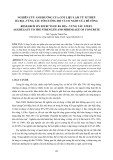
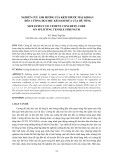
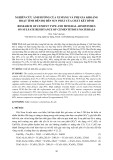
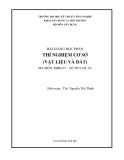



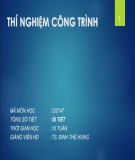

![Bài giảng Quản lý vận hành và bảo trì công trình xây dựng [chuẩn nhất]](https://cdn.tailieu.vn/images/document/thumbnail/2025/20251006/agonars97/135x160/30881759736164.jpg)


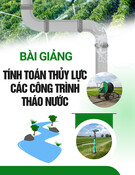
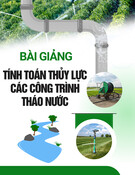
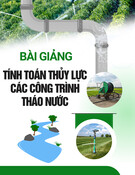
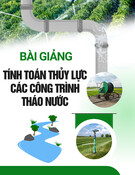
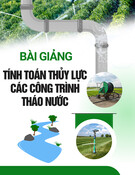
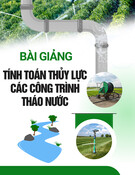

![Ngân hàng câu hỏi trắc nghiệm Sức bền vật liệu 1: [Mô tả/Định tính Thêm để Tăng CTR]](https://cdn.tailieu.vn/images/document/thumbnail/2025/20250920/kimphuong1001/135x160/6851758357416.jpg)

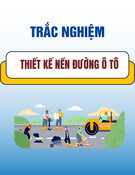
![Trắc nghiệm Kinh tế xây dựng [chuẩn nhất]](https://cdn.tailieu.vn/images/document/thumbnail/2025/20250920/kimphuong1001/135x160/32781758338877.jpg)
